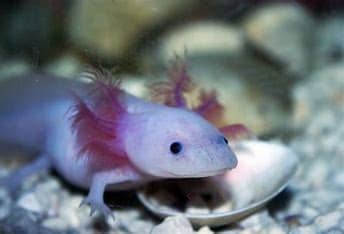Axolotls, otherwise known as Mexican walking fish, are a rare aquatic species that require special care. They have captivating regenerative abilities and unique features such as feathery external gills and a dorsal fin that spans the length of their body. Providing suitable conditions is essential for their well-being.
An aquarium with hiding spots, like rocks and plants, should be spacious and mimic their natural habitat. The water temperature should be between 60 and 68°F (15 and 20°C), and pH levels should be 6.5 and 7.5. Water changes are necessary to keep ammonia levels low.
Axolotls are carnivorous, so their diet should include live or frozen foods such as bloodworms, brine shrimp, and small fish. Varying food sources will ensure proper nutrition.
It is our responsibility to care for these remarkable creatures. By creating an environment that closely resembles their natural habitat and meeting their dietary requirements, we can ensure their long-term health and happiness.
What are Axolotls?
Axolotls are intriguing aquatic beings that spark the curiosity of many animal aficionados. They belong to the salamander family and boast several exclusive features. Unlike most amphibians, axolotls keep their juvenile traits forever, with gills and constantly staying underwater. They reside in a few Mexican lakes and are known for their amazing regenerative powers. They can rebuild lost limbs and even partially heal damaged organs.
They also have a wide assortment of colors, such as pink, gold, and black. Their slimy skin and small eyes on their cute faces add to their appeal. Excellent vision helps them hunt prey underwater.
For those who’d like to keep an axolotl as a pet, it’s important to provide a habitat that resembles their natural one. A large tank of clean water is essential, as they’re sensitive to impurities. Keeping the water healthy is key to their well-being.
In addition, feeding them needs to be done cautiously. They’re carnivores, mainly eating small underwater insects like worms and brine shrimp. Give them a protein-filled diet to help them grow.
Being the owner of an axolotl is highly rewarding. But taking care of them requires dedication and effort. Make sure they have the right environment, proper nutrition, and regular check-ups. This will help you develop a strong bond with your pet axolotl and appreciate its beauty and strength.
Don’t miss out on the marvelous world of axolotls! Adopt one as your companion now. The joy they will bring to your life is incomparable.
Choosing the Right Environment for Axolotls
Creating the right environment for your axolotls is essential for their wellbeing. This will help them grow and stay healthy. Here’s what you need to consider when creating their home:
| Component | Description |
|---|---|
| Tank Size | 10 gallons of space for each axolotl. |
| Water Temperature | Between 60°F and 68°F (15°C – 20°C). Heater or chiller can help maintain temperature. |
| Filtration System | Essential to keep water clean and maintain ideal levels of ammonia, nitrate, and nitrite. |
| Substrate | Soft substrate like sand or smooth pebbles to prevent injuries. |
| Hideouts | Caves or plants for axolotls to hide in and feel secure. |
| Lighting | A dimly lit tank with ambient light to maintain natural rhythm. Also, be careful with using bright light sources as this can cause stress and harm their delicate skin. |
Live aquatic plants are a great addition as they look nice and absorb harmful substances like nitrates. Lastly, regularly check the water parameters and do water changes to keep the environment clean and healthy. Follow these tips to make sure your axolotls thrive!
Feeding Axolotls
Axolotls are rare aquatic species. To thrive, they require a specific diet. Providing proper nutrition is essential for their wellbeing. Here’s what they feed on:
- Offer a variety of foods that mimic their natural diet – live or frozen bloodworms, brine shrimp, daphnia, small insects and small fish.
Axolotls are opportunistic feeders – eating whenever food is available. But, overfeeding can cause obesity and other health issues. Recommended to feed adult axolotls 2-3 times a week and juveniles daily.
Use feeding tongs or tweezers to place food in front of the axolotl’s face. This ensures they notice and consume their meal. Also prevents excess food from sinking into the substrate unnoticed.
It is crucial to prevent them from ingesting any substrate along with their food. Substrate ingestion can cause digestive system blockages and severe complications.
Occasionally feed your axolotl earthworms. They provide essential nutrients and promote natural foraging behavior. Monitor their weight and adjust feeding portions.
Centuries ago, Aztecs revered axolotls due to their unique regenerative abilities. Now, they are popular pets among enthusiasts worldwide.
Providing Proper Care and Maintenance
Caring for axolotls is essential for their health and happiness. These unique aquatic animals need special attention and environment. Here’s a step-by-step guide to caring for your axolotl:
- Create a habitat: Use a roomy tank with clean, filtered water. Axolotls need space to swim and hide. Do not use gravel, as it can be swallowed and harm your pet.
- Keep the water in optimal condition: Measure the water temperature, keeping it between 60-68°F (15-20°C). Check pH levels and ammonia content with a water test kit. This will keep your axolotl safe.
- Feed a balanced diet: Give live or frozen food such as earthworms, brine shrimp, or bloodworms. You may also give them commercial pellets designed for axolotls.
- Give them places to hide: Axolotls are timid creatures and need hiding spots. Use rocks, caves, or plants to provide cover and imitate their natural environment.
- Clean the tank regularly: Remove uneaten food, waste, or debris. Change the water partially every week to maintain optimal conditions.
- Monitor their behavior: Observe your axolotl’s behavior for any signs of illness or distress. Notice any changes in appetite, sluggishness, or unusual growths. See a vet if there are issues.
Also, axolotls have regenerative abilities, which let them regrow lost body parts such as limbs and even parts of their heart or spinal cord when hurt. This makes them interesting creatures to look after.
To care for your axolotl:
- Do not handle them too much, as it can stress them out.
- Moving them from one place to another? Use a gentle net to avoid injury.
- Keep their tank dark, similar to their natural habitat.
By following these suggestions, you can provide the proper care and maintenance for your axolotls. This will help them stay healthy and happy.
Axolotl Breeding and Reproduction
Breeding and reproducing axolotls needs special care. See the table below for basics:
| Aspect | Details |
|---|---|
| Mating season | Feb to June |
| Courtship rituals | Rubbing heads, tail wagging |
| Egg-laying | Females lay on plants or rocks |
| Number of eggs | From 100 to 1,000 |
| Incubation period | 2-3 weeks |
| Care for eggs and larvae | Water temp & quality important |
Also, these animals can regrow body parts like salamanders. But they don’t go through metamorphosis when they become adults.
To have good breeding and reproduction, keep the environment right. The temp and water quality must be perfect. Give the female hiding spots too. Watch them during courtship to make sure it’s safe.
Pro Tip: Handle the eggs lightly – they’re delicate and could break.
Conclusion
Caring for Axolotls at home takes dedication. To ensure their health, provide the right environment, nutrition, and monitoring.
Water quality is very important. Change the water regularly to avoid dangerous waste or nutrients. Pick filtration systems that remove bacteria and maintain water parameters.
Axolotls need a varied diet of live food, like bloodworms, brine shrimp, and daphnia. Don’t overfeed them; this can lead to obesity.
Create an environment similar to their natural one. Include rocks, plants, and low light.
Tip: Add a secure lid to the tank. Axolotls may try to escape if they can.
By following these steps, devoted Axolotl owners can enjoy these fascinating creatures in their homes. They have a special look, behavior, and can even regenerate!
Frequently Asked Questions
FAQs: Rare Aquatic Species: Caring for Axolotls at Home
1. What are axolotls and why are they considered rare aquatic species?
Answer: Axolotls are a type of salamander found primarily in lakes near Mexico City. They are considered rare because they are critically endangered in their natural habitat due to habitat loss and pollution.
2. Can axolotls survive outside their natural habitat?
Answer: Yes, axolotls can survive and thrive in home aquariums given the right conditions. However, it is important to closely replicate their natural habitat, including maintaining proper water temperature, pH levels, and providing hiding spots and a suitable diet.
3. What kind of tank setup do axolotls require?
Answer: Axolotls require a tank with a minimum size of 20 gallons for a single axolotl and an additional 10 gallons for each additional axolotl. The tank should have a secure lid to prevent escapes and should be filled with dechlorinated water, maintaining a temperature between 60-64°F (15-18°C).
4. What do axolotls eat and how often should they be fed?
Answer: Axolotls are carnivorous and primarily feed on small live or frozen foods such as bloodworms, brine shrimp, and daphnia. They should be fed once a day or every other day, with the size of their food portions being no larger than their head to prevent choking.
5. How often should the tank water be changed?
Answer: Axolotl tank water should be changed at least once a week. A partial water change of 25-50% is recommended, using dechlorinated water of a similar temperature and matching pH levels to reduce stress on the axolotls.
6. Can axolotls be kept with other fish or aquatic species?
Answer: Axolotls are generally best kept alone or with other axolotls of similar size. They have a tendency to nip at the fins of other fish, and some fish may even see axolotls as prey. It is important to research and carefully select tank mates if planning a mixed species tank.

